For my CIP, I have been taking weekly lessons in shodō, or Japanese calligraphy. I was introduced to my teacher, Asakusa-sensei, by a classmate’s host mother. Every Wednesday after lunch, I take the bus to Shimogamo Jinja bus stop, then walk a few minutes to Asakusa-sensei’s home where the lessons are held. The classroom is small but comfortable, mostly occupied by a large table and chairs—this was a pleasant surprise, since given what I’d seen of other CIPs related to traditional culture, I’d been bracing myself and my knees for an hour of sitting in seiza. Since I’m the only student with a lesson during my time slot, I’ve been able to interact one-on-one with my sensei far more than I expected, and I’m exceptionally glad to have had that opportunity.
The structure of my lessons is always more or less the same: each week, I determine what it is I want to work on writing (generally 3-5 specific kanji, though we’ve also worked on my hiragana handwriting) and bring a list with me. Asakusa-sensei then demonstrates each character so I have an example of the stroke order, and I practice each one a number of times, with Asakusa-sensei providing input on what to fix and what I did well. In theory, this kind of lesson in a one-on-one situation seems kind of daunting, and at first I was nervous during my lessons due to both my lack of experience and a fear of messing up my Japanese or accidentally being rude by poorly employing honorific language. However, the more I talked to her, the more comfortable I felt during lessons. It also helped that Asakusa-sensei is extremely friendly—overall she reminds me very much of a peppy grandma.
Though I’ve definitely slipped into informal speech from time to time out of habit, on the whole I’ve been able to use and get better at a more formal, less casual way of speaking. This has provided what I think is an important supplement to my Japanese class and the speaking practice I’ve gotten with my host family, since it’s more formal than, say, chatting with my host mom, as well as more natural and conversational than most interactions with professors. Though there are still times that one of us will have to look up a word (for example, I didn’t know the Japanese word for thunder and my attempt to describe it was more awkward than helpful) to keep the conversation alive, I feel that overall my communication ability has increased greatly as a result of these lessons.
Another benefit of my CIP is what comes after each lesson. After my very first lesson, I was surprised and delighted when sensei brought out a cup of tea and a cookie and offered them to me. Though my actual time slot is from 2:00 to 3:00 in the afternoon, we ended up chatting over tea until 3:30 or 3:45. This is a weekly ritual; after I’ve finished my calligraphy and cleaned my brushes, sensei will duck into the other room for a few moments and return with a hot cup of tea (in a ceramic cup she made herself, no less!) and a small snack of some sort and we’ll talk for another half an hour or so. I’ve found that during these conversations we talk a lot about what I’m learning in my classes, as well as discussing cultural differences between my background and hers. I feel really fortunate to have this kind of cultural exchange; compared to the other people I interact with in day-to-day life, Asakusa-sensei has far less experience with exchange students, so there’s a much different kind of mutual learning that happens in these conversations.
Entirely secondary to the social and language-related benefits, I’m also very happy to have taken these lessons from an artistic perspective. Part of my initial interest in Japanese calligraphy came from my hobby of English calligraphy, and investigating the differences between the two practices as well as letting shodō influence my English work has been an enlightening experience as well. I also feel that paying such deep and individual attention to writing kanji, including really looking at the radicals that compose them, has given me an added edge when learning kanji in an academic setting. Where before I struggled to remember and make sense of the characters, the intensive work with kanji has functioned much like studying word roots did for me in English; specifically, writing them slowly and with intention and thought has allowed me to pay attention to their pieces and configurations, drawing connections between characters and words that previously seemed unmanageably different.
Both socially and linguistically, I feel that my CIP has really rounded out the rest of my experiences at KCJS. From a more personal standpoint, I am also very grateful for the weekly chance to slow myself down and give something my undivided, almost meditative attention—and then enjoy cultural exchange over a fresh cup of tea.
「Private or Group Lesson (Non-Sports)」カテゴリーアーカイブ
John Cho: Shamisen
For my CIP, I am learning shamisen under Iwasaki Sensei, who teaches in a cafe close to Kawaramachi Station. I chose to play the shamisen because I had a lot of previous background in playing musical instruments, and I wanted to experience the “traditional music” of Japan.
As I only had 1 year of Japanese under my belt, I was, at first, a little intimidated of learning under Iwasaki sensei, as it was a group learning session, not a private lesson. Also, the fact that Iwasaki sensei had a heavy Kansai-ben made me a little more nervous than I should have been. However, all my doubts disappeared after my first lesson. Iwasaki sensei was a very outgoing and kind teacher, and it was very evident that she really wanted to take care of her foreign students (two of my classmates also studies shamisen and koto under her).
From my lessons, I think I definitely improved my shamisen skills. Iwasaki sensei is a fantastic and capable teacher, and I am lucky to have such talented instructor. Aside from my musical abilities, I learned a lot about Japanese culture, current events, and bits of Kansai-ben from the group dinner. Iwasaki sensei likes to eat dinner with every one of her students, mostly because she just loves to chat with everyone. During my numerous dinner gatherings with her class, I talked about something as important as my academics and something as trivial as bird migratory patterns in Japan. Also, whenever I had a question about the cultural aspects of Japan (for example, why does one of the student use “casual” speech and not “respectful” speech), she will always answer me to the best of her ability, even using few English words in her sentence just so that I could understand better.
For anyone who wants to have an authentic experience of “Japanese Life” with the locals, hanging out with Iwasaki sensei in her dinner group is a good place to start; and to those who want to learn traditional Japanese music, I would highly recommend the shamisen lesson.
John Evans: Art Lessons at Apollo Academy of Fine Art
After hearing about it from Lisa Qi and Yamaoka Sensei, I started attending art classes at the Apollo Academy of Fine Art in late September. Every Thursday, I would ride the subway from Doshisha to Karasuma Oike. Afterwards, I would walk several blocks southwest to the apartment building in which the classes took place, surrounded by various stores and traditional merchant homes (machiya). Though the idea of a class in an apartment seemed strange to me at first, the class was very comfortable and organized and had the familiar accumulation of random sculptures, kitchenware, and fake flowers used for still lives back home.
I was initially thrown off by the fact that the majority of students were adults, many around my dad’s age – I had been expecting students around my age. The students were more or less consistent every week and had been attending for quite some time. As of such, they were very talented. There was the occasional foreigner that came to classes, though we still spoke in Japanese. I would spend 3 and a half hours working, though the professor and the other students often urged me to stay longer. I had no materials with me in Japan, but luckily the professor sold them, (i.e. pencils and a sketchbook). Throughout the class period, the professor would walk around the room, pointing out strengths and weaknesses in everyone’s work, but I often had a hard time understanding his suggestions since I lacked the proper vocabulary, which led me to search for helpful words to use in future classes. I had initially signed up for watercolors, but for the first month and a half I only worked on still life drawings. However, I reminded the professor I would only be attending until December, which allowed me to start painting a little earlier.
Although all of the students were serious about their art, the class was not solely work. About halfway through, the professor and his colleague would set out snacks and tea. This break was a great opportunity to speak to get to know others in the class. My classmates often asked me not only about my hometown, but my family’s heritage, which I personally do not know a whole ton about since it is not a common conversation for me back in the US. I was also surprised after I contributed tea one week because I was thanked the following week as well, even though it had seemed very minor to me. Like many American students, I had only ever had female Japanese teachers, which led to issues understanding my professor and my male classmates. I received the occasional chuckle and comment about being “cute” or “too formal” because I was so used speaking formally. However I have had more experience speaking casually after this class. One of my classmates who was designing a poster would occasionally ask me to check her work to see if the spelling and meaning made sense in English. I also received invitations to my classmates’ exhibitions and galleries in the area.
Overall my experience in this class was very rewarding because I was able to sue Japanese in a somewhat “familiar” environment and meet various people who shared my own interests, regardless of background.
Benji Hix: Private Koto Lessons
For my CIP, I chose to take private koto lessons. This seemed like a natural choice, given that it had some relation to my major, music. Every week, I took the subway to a little building called the Greenwich House hidden away in downtown Kyoto and practiced with my teacher in a cozy little room full of koto, shamisen, and shakuhachi. It always felt a little magical; the room was lit entirely with lamps scattered around the room, and every square inch of the room was covered; the floor was laden with instruments and furniture, the walls with pictures and newspaper articles, and every spare surface with tuners and sheet music. From the first time I stepped into the room while an ensemble was practicing, it seemed like the perfect environment to make music.
My biggest concern with picking this CIP was the “private” aspect; I was afraid of missing out on the opportunity of making Japanese friends through my CIP. It was a very pleasant surprise, then, when upon entering my second lesson I learned that every lesson would be a group lesson with at least four or five other students, all of whom were Obaachan and Ojiisan! Each week I seemed to meet at least 5 new people, and everyone was exceedingly kind and patient. Learning a new instrument is a lot less stressful when it feels like you constantly have 5 grandmas cheering you on and calling you cute the entire time! On the average day, we would practice for about an hour, then head to dinner as a big group, and this was where the majority of language practice occurred. Through these dinners, I picked up many little tidbits of Japanese culture––the insistence of paying for other people, the unspoken rule of only pouring alcohol for other people, the amount of crazy antics that Obaachan can get away with, and plenty more. Furthermore, having only ever had female teachers, my comprehension of elderly male speech was admittedly terrible before getting the weekly practice provided by my fellow students. These dinners were my favorite part of the entire CIP experience, and erased any doubts I had about picking it.
And of course, getting to learn a traditional Japanese instrument was an amazing opportunity! From a music theory perspective, it’s provided me with some new insight into traditional Japanese pentatonic scales, and the various chordal progressions possible without access to the traditional 8 note scale. One of the most enjoyable parts of playing for Koto for me is the ease with which one can retune the 13 strings; just like a guitar, one can tune the strings to whatever scale one pleases, but the process is significantly faster than any other traditional string instrument, and is done simply by moving small plastic stands up and down the body of the instrument. The sheet music for koto is also completely different from standard western notation; rather than notes on a staff, the music is completely represented through kanji inside of boxes. It provided a real challenge, forcing myself to think of rhythms and chords in a drastically different visual style. Overall, learning Koto has provided me not only with interesting new insights into music, but also with a plethora of funny and interesting stories thanks to all the fun dinners! I would recommend this CIP to anyone with any sort of instrument experience; it’s truly a rare opportunity.
Jose Trejos: Cooking Lesson
When choosing my CIP activity, I hoped to find an activity that I could continue to perform after I leave Japan, and would allow me to explore an aspect of Japanese culture that the study abroad experience does not typically emphasize. Through this logic, I decided to take a weekly Japanese cooking class for my CIP, at the La Carriere Cooking School. I have always enjoyed cooking at home for my family, and I personally consider Japanese food to be the best in the world, so the opportunity to expand my knowledge in classes taken by actual Japanese people was a unique opportunity.
While taking my cooking class, I had the opportunity to interact with Japanese people outside of a classroom or host family setting, which expanded my understanding of Japanese culture. Something that immediately surprised me when I started to attend was that we were expected to wash the dishes during and after we finished cooking, which would not be orthodox in this type of cooking class in the west, and I felt tied in to a Japanese ethic of respect for the teacher and of not troubling others. Other aspects of the students gradually stood out to me, from the fact that the class was largely divided between young professionals and old retirees with few people in the middle, which reflects work dynamics in current Japan, to the different ways the students reacted to American, Costa Rican and (through some recipes) French culture. I also learned much of the kanji and words used to describe French food, and even became much better at deciphering Japanese onomatopoeia as my teacher struggled to communicate instructions to me.
However, it is true that by taking a class rather than a group activity, the amount of interaction that I had was limited compared to that of other KCJS students, and the varying attendance of these classes meant that my interactions stayed formal with most of the cooking students. In reflection, it may be better for students that are not particularly extroverted to aim for activities that more directly emphasize interacting with Japanese people, such as activities in Doshisha’s circles. Regardless of the activity, it is crucial to pay attention to the routines of Japanese society to the extent that one is capable, as managing basics such as proper aisatsu matters a lot more than equivalent pleasantries do in the US. Most importantly, realize that while it is inevitable to embarrass yourself with Japanese several times, you will never see the people again at the end of the CIP, and there is no reason not to be bold and practice as much as you can talking to Japanese people. Much like the host family, the CIP is a type of interaction that a class or individual practice is completely incapable of providing, so putting in effort is very important to how much Japanese you ultimately learn studying abroad.
Lisa Qi: Apollo Art Academy
For my CIP I chose to enroll in Apollo Art Academy, an art school that was only about a 10 minute walk from my homestay. My hobby has always been drawing, so I wanted to get involved with art in some way during my stay in Japan.
A fellow KCJS classmate, John Evans, also enrolled into the same school as me and we both had classes on Thursdays. The thing about art classes is that they usually span over a long period of time, so it came as no surprise to me that the class I took ran from 1:30pm to 5pm. In fact, most of the other students in our time slot stayed longer than 5pm to get more progress done on their works.
When we first arrived at the academy, I was not sure what to expect, but Tanaka-sensei and everyone else were very welcoming and helped us fill out the short application sheet. Afterwards, we started with a trial class before beginning an actual lesson course. Evans-san and I had both originally wanted to take watercolor or oil pastel lessons, but Tanaka-sensei started us out with pencil and wanted us to slowly progress upwards to working with color.
Originally, I had been considering joining an art circle at Doshisha University, but I am glad that I chose to enroll at Apollo instead, because I heard that art circles usually consisted of students all sitting separately and working silently on their own individual projects, and I felt that I would not had had the chance to practice much Japanese. Midway through each class, everyone gathers around a big table and we get a chance to chat with eachother while eating snacks. In addition, Tanaka-sensei usually walks around the class giving each student individual criticism throughout the class. Though there are times where I am not 100% sure if communication was clear, attending these classes has been a very fun experience getting to know the other students in my class while also improving my art skills and I will most likely continue with this CIP in spring semester.
Gerlin Leu: Koto
The koto classroom’s homely layout reflects in the family like welcome of the teacher and students. Well, I say students, but many are retired people who spend all afternoon and evening practicing and hanging out. Besides koto, there are samisen and shakuhachi. Every time I arrive at the classroom, we would wait for the current repertoire to end before we eat snacks, usually omiyage from all over Japan, and drink tea while chatting about current life happenings. Through our conversations, I have learned many trivia about Japanese household supplies and food names. My Japanese language skills have also improved vastly. Everyone in the classroom speaks in a heavy Kansai-ben. While I can barely distinguish the exact words, I have grown to be able to observe the various tones and guess (mostly correctly!) the meaning. However, I have also learned that over text, when I lose the visual hints, I can no longer as successfully figure out Kansai-ben.
Tyler Logan: Kimono Making Lessons
While living in Kyoto this year, I had the opportunity to get involved with life in Kyoto outside of my classes at Doshisha by taking lessons on how to sew kimonos. Because I’m an art student with an interest in clothing and textiles, when I came to Japan I knew I wanted to study kimono making. For that reason, I’ve had a great time so far taking my lessons. Over this semester, both my sewing and Japanese skills have gradually improved. I look forward to continuing my lessons next semester as well.
In the old days, all kimono were sewn by hand, so when I started taking my lessons, I also had to learn how to sew by hand. I had made clothes with a sewing machine for art classes before, but I had never made anything just by sewing by hand. However, my Sensei was able to sew with his hands as fast as a machine. I haven’t become that fast, but with practice I have become more skilled in working with the thread and fabric with my hands. The skills I’ve acquired through my CIP will definitely help me with taking my artistic work in new directions when I return to America.
During our lessons, I was also able to practice speaking Japanese with my Sensei. From cutting, to measuring, to folding, to ironing, to sewing, I always had to keep close to my teacher to know what to do next with the cloth. I didn’t know a lot of Japanese words related to clothes when we started, and my teacher’s accent is a little thick, but gradually I became able to both understand and converse with my teacher about his craft. I’ve discovered so much about the minute details and hidden facets of Japanese sewing, and I couldn’t have gotten these insights without the ability to talk with my teacher in Japanese. I’m definitely glad I was able to take these lessons.
Alan Cheng: Calligraphy (Shodō) Lessons
As a college student, how you fit in within the demographics of students who take calligraphy lessons is quite interesting: either you find yourself sticking out as the oldest among a crowd of elementary school students, or you’re conspicuously the youngest among adults over twice your age. (To be fair, as a foreigner, you pretty much stick out wherever you are but that’s beside the point!) The reason for this is that students who pursue calligraphy as an extracurricular activity typically practice in clubs at school, rather than taking outside lessons, and working folks, of course, hardly have time to take these kinds of lessons.
My class was the latter, and the two other students were both in their 50’s or 60’s (I never asked directly) and at least one of them was a grandparent. Since they’ve both been practicing calligraphy for at least 8 years, their writing already looked perfect in my eyes, so at first I wondered why they were still taking classes. However, it didn’t take long for me to come across the answer: these lessons were also important social gatherings. The students and our instructor always chatted about anything and everything while during our lessons, and the atmosphere was always very warm and friendly. I could tell that, while the student-teacher relationships were always upheld (by the way they were speaking), they were truly friends as well.
Comparing the cultural emphasis on handwriting in Japan to two other countries that I’m familiar with, there’s a similar attitude in China, but America doesn’t value handwriting as highly. My dad, an immigrant from China, was very proud of his handwriting and calligraphy, but he realized that these skills are not nearly as important in America, so unlike my calligraphy instructor, he didn’t feel the need to comb over my handwriting as a child.
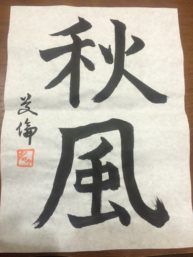
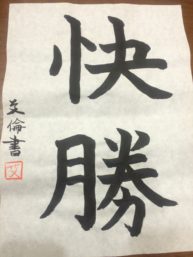
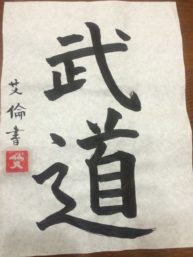
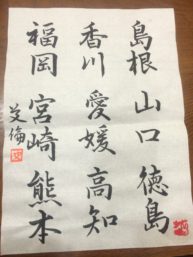
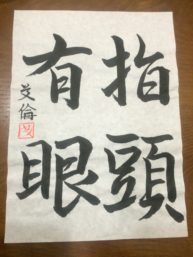
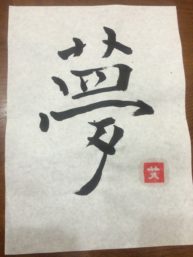
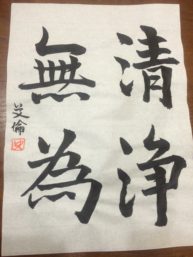
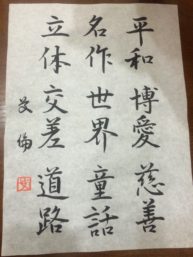
Elizabeth Smith: Nihon Buyou and Ballet
This semester, I have continued with both of my CIP activities: Ballet and Nihon Buyou. Unlike last semester, when I was primarily focused on acclimating into a new environment, I started this semester feeling comfortable with both of my CIPs. This allowed me to delve deeper into both communities![]()
In Nihon Buyou, I am now able to pick up on details that largely escaped me at the beginning. This is in part because my language skills have improved dramatically. Last semester was essentially survival mode: I was only focused on understanding the gist of what my teacher had to say, and had little room to pick up on details or nuance. This semester, I know her better and am more familiar with the repertory that I am studying. This has allowed me to learn more about the history of Nihon Buyou, its links to the Kabuki tradition, and the different schools. For example, both last semester and this semester, my teacher has given me tickets to see Nihon Buyou performed in Pontocho. (This semester, I got to see her dance with her sister!) Compared to last semester I was much more aware of the context what I was seeing, and was able to ask better questions afterwards.
In terms of ballet, I feel like I have become a much more involved member of the community. Last semester, due to a minor injury and the process of adjusting to life in a foreign country, I typically went home right after classes. This semester, because I was more comfortable with life in Kyoto and my injury has healed, I have started staying to wear pointe shoes for an extra half hour after one of my two classes every week. This has given me a better opportunity to get to know the other girls much better. Whereas girls that dance together for several days in a week in America tend to become very close, I at first thought that the atmosphere at K.Classic ballet was much less social. However, spending more time around the girls, I’ve realized that while the dressing room is too small to talk much before and after class, they do have a strong community. They have been incredibly inclusive towards me as well! For example, when one of the girls brought Valentines’ chocolate for everyone, she included me as well! Additionally, girls who I was once intimidated to speak to have approached me to start conversations about my pointe shoes or my training in the US. Little gestures like these have made me increasingly like I have become part of a community.
